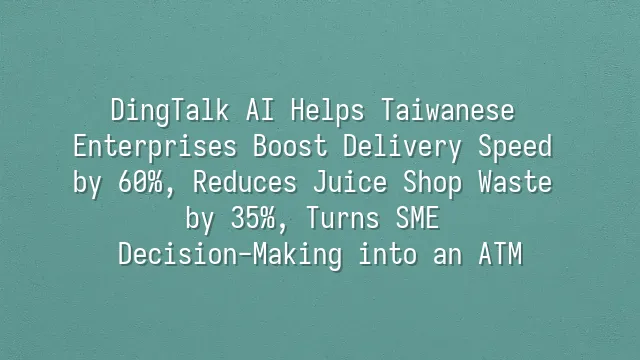
From Firefighting to Foresight
DingTalk AI's competitive edge helps small and medium enterprises break free from the vicious cycle of "running out of stock today, overstocked tomorrow." In traditional models, inventory management relies on experience and guesswork, often resulting in mountains of expired raw materials or sudden shortages of bestsellers. But when data becomes central to decision-making, everything changes. Take Fresh Fruit Era, a juice shop in New Taipei City: after adopting DingTalk AI’s demand forecasting algorithm, the system integrated historical sales, weather changes, holiday peaks, and social media buzz to accurately calculate daily ingredient needs—reducing inventory waste by 35%. Even more impressive? The AI automatically triggers restocking processes. Suppliers receiving alerts have even asked: “Do you have insider information?” This is the essence of the SME strategy guide—replacing intuition with algorithms, turning reactive responses into proactive planning. Rather than counting losses afterward, businesses can anticipate trends, reinvest savings into new flavors, capture market attention, and create a virtuous cycle.
Cutting the Fat Out of Meetings
DingTalk AI demonstrates remarkable impact in communication, especially against the most common SME pain point—the "meeting black hole." Two-hour meetings yielding three-line conclusions, followed by hours waiting for minutes—this inefficient scenario is being completely overturned by AI. With built-in features like speech-to-text, automatic summarization, and action item extraction, real-world tests across multiple SMEs in Taichung show an average saving of 40 minutes per meeting—equivalent to gaining back one lunch break each week. It’s not just about speed, but accuracy. The AI doesn’t just transcribe conversations; it identifies decisions, generates to-do lists, and pushes tasks directly to team members’ workspaces. The all-too-familiar curse of “let’s schedule another meeting to confirm details” is finally broken. For resource-constrained SMEs, this means decisions no longer drown in endless discussions but are swiftly executed. DingTalk AI transforms teams from passive trackers into active drivers—turning meetings from cost centers into engines of output, perfectly embodying the core principle of the SME strategy guide: ultimate efficiency.
The Reflex Arc of Workflow
The true power of DingTalk AI lies in transforming complex processes into instinctive “reflexes.” Behind the YiDa platform, the Connector Factory acts as the enterprise’s AI nerve center, supporting over 15 types of automated actions to achieve end-to-end automation. From the moment an order arrives, the system automatically schedules production, locks inventory, and arranges logistics—all without human intervention. Anhui Xinlian Poultry provides a prime example: even before chickens leave the farm, customs documents and cold-chain vehicles are already ready. This capability stems from AI learning years of SOPs and digitizing veteran experts’ judgment into “if A, then B” logic rules. This automation isn’t cold code—it’s human expertise turned into replicable muscle memory. Crucially, the system continuously collects feedback data, fine-tuning its response speed with every use, getting smarter over time. For SMEs, this means they can build agile, special-forces-like workflows—even without a large IT team. When every step responds as fast as a knee-jerk reflex, that’s when the SME strategy guide is truly put into practice.
The Mind-Reading Task Manager
DingTalk AI’s Adaptive Priority Scoring (APS) algorithm is like mind-reading for task management. It doesn’t just schedule—it senses the rhythm of projects: Who’s nearing deadlines? Who’s idle? Who’s already overloaded? APS dynamically adjusts task priorities to avoid resource conflicts and burnout. After implementing APS, Taiwan-based design firm Creative Workshop saw project delivery speed increase by 60%, thanks largely to the system resolving over 70% of scheduling disputes. Where meetings used to feel like seat-grabbing contests, the system now automatically avoids high-conflict times, reducing meeting arguments by 29%. Smarter still, it learns individual rhythms—if a team member consistently underperforms Wednesday afternoons, the system assigns lighter tasks, as if knowing inspiration only strikes after coffee. This predictive power comes not from magic, but from massive data training. For SMEs, APS maximizes limited manpower, eliminates bottlenecks, reduces internal friction, and fully realizes the value of “intelligent allocation” in the SME strategy guide.
Democratizing Data Alchemy
DingTalk AI is breaking down barriers to data analysis, enabling SMEs to master “data alchemy” too. Once reserved for corporate giants and requiring PhD-level analysts, big data is now accessible through simple natural language queries. Ask, “Which product sold worst last month?” and the system instantly extracts insights from a dataset spanning 3 million enterprises and 4 billion records. The owner of New Taipei’s Fresh Fruit Era, with zero coding background, used predictive models to cut waste by 35%. Anhui poultry companies achieved digital transformation at unimaginable speed via automation. This isn’t just tool upgrades—it’s decentralizing decision-making power. When shop owners can speak casually to uncover sales patterns, data becomes truly embedded in daily operations. In the coming year, we’ll see more small business owners become “data wizards,” using conversational AI to detect operational blind spots. The core of the SME strategy guide has shifted—from “how to get data” to “how to ask the right questions.” And DingTalk AI is the magic wand that turns data into gold.
We dedicated to serving clients with professional DingTalk solutions. If you'd like to learn more about DingTalk platform applications, feel free to contact our online customer service or email at

 English
English
 اللغة العربية
اللغة العربية  Bahasa Indonesia
Bahasa Indonesia  Bahasa Melayu
Bahasa Melayu  ภาษาไทย
ภาษาไทย  Tiếng Việt
Tiếng Việt  简体中文
简体中文 